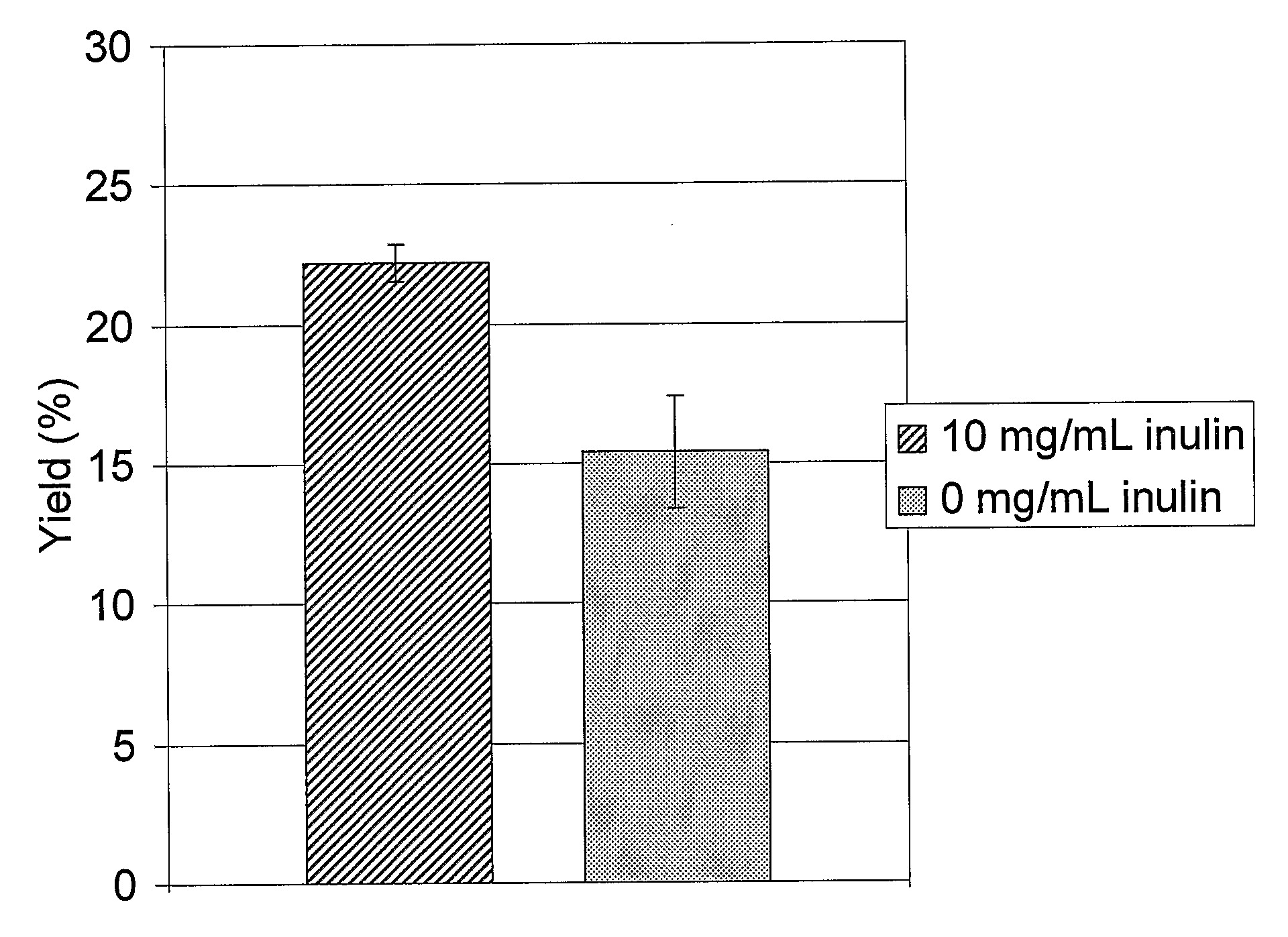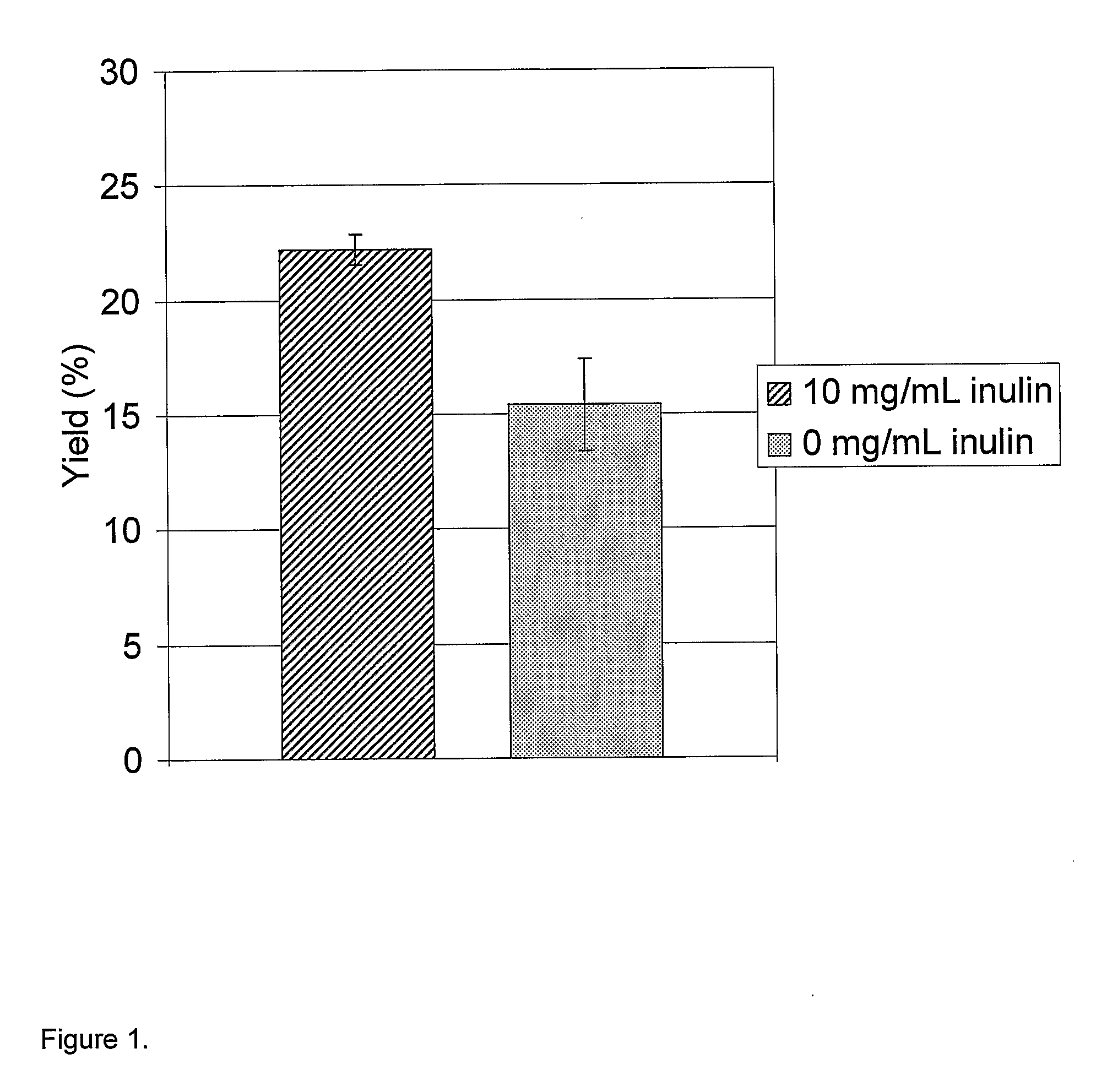Methods And Kits For Folding Proteins
- Summary
- Abstract
- Description
- Claims
- Application Information
AI Technical Summary
Benefits of technology
Problems solved by technology
Method used
Image
Examples
example 1
Refolding Lysozyme Using Inulin (Inutec N®25)
[0164]Lysozyme (Fluka 62971) was denatured overnight at 4° C. in 100 mM Tris-HCl buffer at pH 8.1, containing 1 mM EDTA, 8 M urea and 32 mM DTT. The denatured protein (5.0 to 20.0 mg / ml) was diluted 20 times into a refolding buffer (67 mM Tris, 5 mM oxidized glutathione, pH 6.5). In half of the samples, the refolding buffer also contained 10 mg / ml inulin (Inutec N25, Orafti). The reactions were performed in the wells of a 96-well microplate.
[0165]The samples were then incubated for 24 hr at room temperature (approx 25° C.) to allow refolding. Lysozyme activity (protein folded to a native, active configuration) was determined by measuring the initial linear rate of decrease in turbidity (absorption at 492 nm) of a Micrococcus lysodeikticus (Sigma M-3770) solution. The Micrococcus concentration was 0.75 mg / ml in 67 mM sodium phosphate buffer at pH 6.25. The Micrococcus solution was mixed with the solution containing the refolded lysozyme in...
example 2
Carbonic Anhydrase (CAB) Refolding Using an Alkyl Inulin Derivative
[0167]Carbonic Anhydrase (Sigma C-3934) was denatured overnight at 4° C. in 50 mM Tris-Sulfate buffer at pH 7.8, containing 8 M urea and 32 mM DTT. The denatured protein (2.5-10.0 mg / ml) was refolded by 20 times dilution into a refolding buffer (67 mM sodium phosphate, pH 7.0, containing various concentrations of an alkyl-inulin derivative (Inutec®SP1, also referred to as alkyl-inulin, or SP1) and incubated for 2 hours at room temperature. The carbonic anhydrase activity was determined using a para-Nitrophenol assay and compared with a standard curve created using standards of native carbonic anhydrase at known concentration. The refolded protein samples (or standards) were diluted 10 times with Tris-sulfate buffer at pH 7.8. Para-Nitrophenol was dissolved in a 1:1 water and ethanol solution to a concentration of 10 mM. Five percent by volume of the para-nitrophenol solution was then added to each diluted protein sam...
example 3
Lysozyme Refolding Using an Alkyl Inulin Derivative
[0169]Lysozyme (Fluka 62971) was denatured overnight at 4° C. in 100 mM Tris-HCl buffer at pH 8.1, containing 1 mM EDTA, 8 M urea and 32 mM DTT. The denatured protein (5.0 to 20.0 mg / ml) was refolded by dilution 20 times into a refolding buffer (100 mM Tris, 1 mM EDTA, 5 mM oxidized glutathione, pH 8.1). The samples were then incubated for 24 hours at room temperature to allow refolding. Lysozyme activity was determined by measuring the initial linear rate of decrease in turbidity (absorption at 492 nm) of a Micrococcus lysodeikticus (Sigma M-3770) solution. The Micrococcus concentration was 0.75 mg / ml in 67 mM sodium phosphate buffer at pH 6.25. The Micrococcus solution was mixed with the solution containing the refolded lysozyme in the ratio 10:1 (e.g. 200 μl Micrococcus solution, 20 μl refolded lysozyme solution). Standards of native lysozyme were used to generate a standard curve to calculate the refolding yield.
[0170]FIG. 4 sho...
PUM
| Property | Measurement | Unit |
|---|---|---|
| Temperature | aaaaa | aaaaa |
| Temperature | aaaaa | aaaaa |
| Concentration | aaaaa | aaaaa |
Abstract
Description
Claims
Application Information
 Login to View More
Login to View More - R&D
- Intellectual Property
- Life Sciences
- Materials
- Tech Scout
- Unparalleled Data Quality
- Higher Quality Content
- 60% Fewer Hallucinations
Browse by: Latest US Patents, China's latest patents, Technical Efficacy Thesaurus, Application Domain, Technology Topic, Popular Technical Reports.
© 2025 PatSnap. All rights reserved.Legal|Privacy policy|Modern Slavery Act Transparency Statement|Sitemap|About US| Contact US: help@patsnap.com



